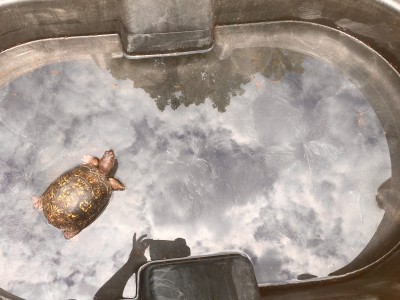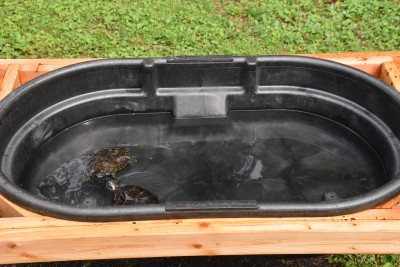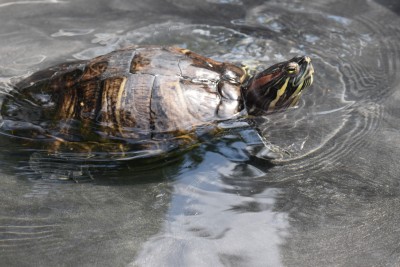Two years ago this summer, I was one of eighteen lucky college students invited to attend a three month internship on idyllic Bald Head Island, North Carolina. I anxiously packed my life into a suitcase and carry-on, never having lived outside my parents’ home in southeast Michigan. I boarded my planes hoping for an exciting summer opportunity, never thinking about how much that three months could change the course of my life.
When I stepped off the plane I met my first new roommate. His name was Joe Seebode. Although I was incredibly nervous to start this new chapter with absolutely no experience doing this kind of work, after talking to Joe for a few minutes a calmness washed over me and I knew I was going to experience something wonderful. Throughout my summer I felt a lot of emotions — one of them being terror. Like I said, I had no idea what I was doing and even considered quitting within the first week. With Joe’s kind words and encouragement I stuck it out and absolutely fell in love with environmental education. I overcame my fear of snakes, helped release baby sea turtles into the ocean, and learned how to use ambassador reptiles in education and how to take care of them. As our summer winded down I waved goodbye to Joe as he boarded the passenger ferry we met on, not knowing at the time how much his future would affect my own. I have moved around a lot since then, embracing the nomadic intern life, but used these connections from my past as a map to help me figure out where I was headed. I was fortunate enough to reconnect with Joe this past May as he was ending his two-season stint as an environmental education intern at Shaver’s Creek — just as I was about to start mine.
Joe took me to get ice cream at the Whipple Dam Store as an initiation, if you will, when I first arrived in Pennsylvania.
You might have thought that this blog post was going to be about a sappy reconnect of old friends (which it is — Hi Joe!) but really, I wanted to give credit to the wonderful person who has helped take such great care of Shaver’s Creek’s reptiles! Although we are well known for our birds of prey, we house more than twenty snakes, turtles, frogs and toads which need to be taken care of as well. Joe and I both found our passion for taking care of animals while living on Bald Head, and we have continued to bring this knowledge to our present experiences. Before Joe left the Creek he made it his mission to make sure their care lived on by creating a basking table for our turtles, and I am happy to say I have helped fulfill one of his goals by encouraging its use (but more on that later).
A basking table, you say? What does that even mean? Well, if you have ever walked down the Boardwalk Trail here at Shaver’s Creek and were especially observant, you might have noticed a few painted turtles looking as if they were sunbathing on a log, just as humans might do at the Whipple Dam beach. They are not trying to get a nice summer glow, but use the sun in a different way. In order to understand their use we must first learn why basking in the sun is so great for humans, too! A very important vitamin we need to keep ourselves healthy is vitamin D. It helps absorb calcium in the body, promoting strong bones and teeth, preventing seasonal depression in the winter months, and can even strengthen our immune system. Vitamin D is so important, in fact, that our body produces it all on its own with a little help from the sun! In order to get proper amounts of vitamin D production, you must expose your bare skin to natural sunlight throughout the day. You can do this by taking a stroll through your neighborhood, hiking a scenic mountain trail or catching some rays while splashing around in the pool. Using proper sunscreen is important, of course, if you plan to be outside longer than fifteen minutes. However, fifteen minutes outside is plenty to get this vitamin production started.
A northern water snake is seen basking on a rock (photo by graduate assistant Jerod Skebo)
Now that we have a little background about why it is important for humans to get outside in the sunshine, it is easy to understand why it is helpful for reptiles! Turtles and snakes must also bask in the sun for many of the same reasons humans do. Reptiles are ectothermic or “cold blooded,” as I was told growing up. This doesn’t mean they have cold blood necessarily, but they cannot regulate their own body temperature quite like we can. They need to use a rock in the sun or the shade of a forest to help themselves warm up or cool down. When you observe a turtle sitting out of the water on a log or a snake spread out across a path, they are trying to increase their temperature. This is why you are more likely to run into one on a warm spring day. As they are upping their body temperature, the reptiles are simultaneously producing vitamin D3, which will help them build strong bones and shells. That’s right! Reptiles are vertebrates, which means they have spines just like people. Even turtles have a spine attached to their shell, although all of my favorite childhood television shows convinced me they could take it off at night before bed (looking back, I should have known this could be false information … turtles don’t sleep in beds!).
Turtles will often sit with one another as they bask on large rocks and sometimes even piled on top of each other! Pictured here are a combination of map, snapping and painted turtles. — Photo by Jerod Skebo
Reptiles held in captivity do not get as much natural sunlight but can be compensated with UVB light bulbs above their enclosure. UVB light is the type of ray that is essential in vitamin D3 production.You might be wondering whether or not we could just give them a supplement like humans can take. There are some reptiles that can only produce this vitamin in their skin and cannot use supplements to do so. Therefore, it is very important they are exposed to this light on a daily basis. We like to believe even though we can provide reptiles with this light using artificial bulbs, it is an opportunity to give them some enrichment in their lives so they are not stuck in a small enclosure all day long. You can think of it as similar to when you take a dog out for a walk on their leash.
Our Eastern Box Turtle is checking his surroundings as he meanders his way around a shallow pool of water. Box turtles are part of the pond slider family, but yet are rarely seen in the water. They do not have much webbing in their toes, if any at all, and typically can only stand in shallow creeks. Their domed back shell called a carapace is shaped much like a rock, and could possibly sink the turtle that can not swim like their other family members.
This is not to say we weren’t taking excellent care of our animals before Joe came along, but he recognized this important enrichment opportunity we were missing out on. He took to work and created a wooden frame that balances a plastic bin on top. When we fill it with water our turtles then have a safe place to hang out in the sunshine and swim around in a larger space.
Our snakes like basking just as much as our turtles do, so taking them out for a walk while they wrap around our arms gives them a good opportunity to stretch their legs, so to speak, and even take a nap on one of our laps.
Josh Sanko, one of our committed work study students, is pictured here holding one of our black rat snakes. The snake felt so comfortable being held by Josh, it ended up sitting still for quite some time.
I have encouraged taking our turtles and snakes outside in the sunshine for at least fifteen minutes a week. Our work study students, summer interns, and volunteers have embraced this new part of our routine with open arms. I have worked on creating a schedule for this procedure to make sure it will be kept up after I am gone so Shaver’s Creek can continually have happier, healthier reptiles.
Pictured is our red-eared slider, which is an invasive species in much of the United States. Although they make adorable babies, these turtles can grow quite large and need a lot of space to swim around. Many people love their turtles, but will set them free into their local water source once they get too big. They often out-compete other native species of turtles, making their presence a not-so-great addition to our ecosystem here.
Next time you visit us and one of our turtles or snakes seems to be missing from its enclosure, take a look behind our eagle enclosure, as you just might find them basking in the sun — and maybe you can even join them!
Our Wood turtle uses his rock as a way to take a break from swimming around. Wood turtles can be seen in shallow creeks and woodlands, hence their name, and should be given plenty of opportunities to experience both habitats here at Shaver’s Creek.
Pictures taken by Kristen unless otherwise specified.








